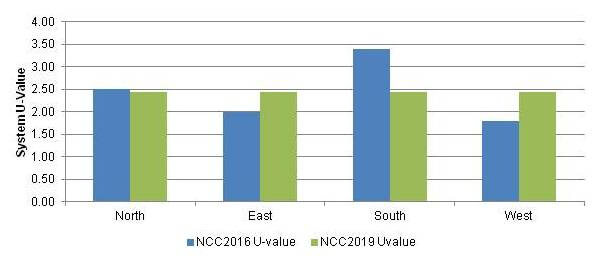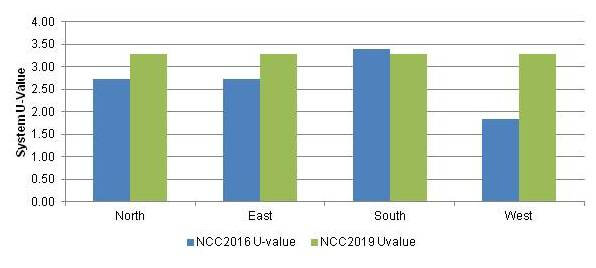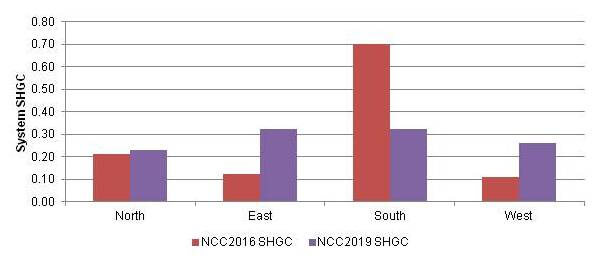

With the release of the NCC 2019 approaching (expected for May 2019) we have taken some time to familiarise ourselves with the proposed changes to Section J. In particular, we focused on the Deemed-to-Satisfy (DTS) Section J1.5 Wall-Glazing Construction which proposes a new approach in which wall and glazing performance is calculated as a system value and different orientations and levels can be assessed together.
Before we start it is worthwhile pointing out that with the amount of glazing in typical commercial buildings (the industry currently seems to like between 60%-80% WWR) being the big issue from a thermal performance point of view, achieving compliance following a DTS approach has always proved challenging. As such, compliance following the DTS pathway is generally limited to small developments with a WWR of less than 40%-50% and with appropriately designed external shading.
Nonetheless, for argument and comparison sake, let’s have a look at what glazing system a hypothetical single-storey office building in climate zone 6, with a 70% WWR and no outdoor shading would need to specify in order to achieve compliance under either the NCC 2016 or 2019 DTS pathways.
As shown by the graph below, following the NCC 2016 DTS approach results in varying system U-Values based on facade orientation. On the other hand the NCC 2019 DTS approach offers a more streamlined result with a consistent system U-value of 2.43. Here it is important to note that such consistency in U-Values is only achieved if the external walls in each orientation have the same U-Value. As we shall see later on, if the U-Value of the walls changes, then the resultant U-Value of the glazing is also likely to change.

Similarly to what we have seen for the U-Value, the system SHGC varies across orientations when using the NCC2016 DTS approach, but remains constant at 0.19 across all facades when using the 2019 DTS approach. Again, this is only the case if the same WWR and shading multiplier are applied across the various facades.
These results indicate that for typical commercial buildings both the NCC2016 and NCC2019 require arguably unrealistic performances in the current Australian market, where standard aluminium frames and clear glazing remains the most popular choice. However, it could be said that at the very least the 2019 approach seems to provide a more flexible approach to the ‘strictness’ characteristic of a prescriptive approach. This is especially the case once orientation-specific design responses are implemented.
Again just for argument sake, let’s assume that our case study building achieve a Total R-Value for external walls 10% better than current requirements for class 5 buildings in climate zone 6 (i.e. RT3.08) and that a 300mm shading projection is included just above the windows on the north, east and west orientations.
In this instance we can see that while the NCC2016 will still mandate fairly low and arguably unrealistic U-Values, the NCC2019 approach by taking into account the increased performance of the walls will require a U-Value of 3.28. While this can still be considered as a relatively performing window system it could be achieved by a standard aluminium frame.

In relation to the SHGC that would be required after the inclusion of external shading the performance remain relatively high regardless of the NCC version used. However, the NCC 2019 seems to provide a more streamlined solution across facades.

From this brief analysis we can conclude that the NCC 2019 provides a slightly more flexible approach for assessing external walls and glazing performance following the DTS pathway. However, the DTS requirements remain fairly strict and it would be unlikely that a typical commercial building would be able to achieve compliance following this method, unless the facades are optimised to suits the environmental conditions of their orientations and highly performing window systems are specified. An alternative verification method, such as the JV3 or from 2019 a NABERS or Green Star rating, will likely remain the most appropriate pathway to demonstrate compliance for most commercial buildings.
Finally, it goes without saying that we welcome the changes to the NCC 2019 in relation to Section J as these should bring Australian building regulations back in line with other developed countries and will also play an important contribution in the effort to reduce our national greenhouse gas emissions and support the development of industries that gravitates around energy efficiency.